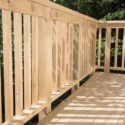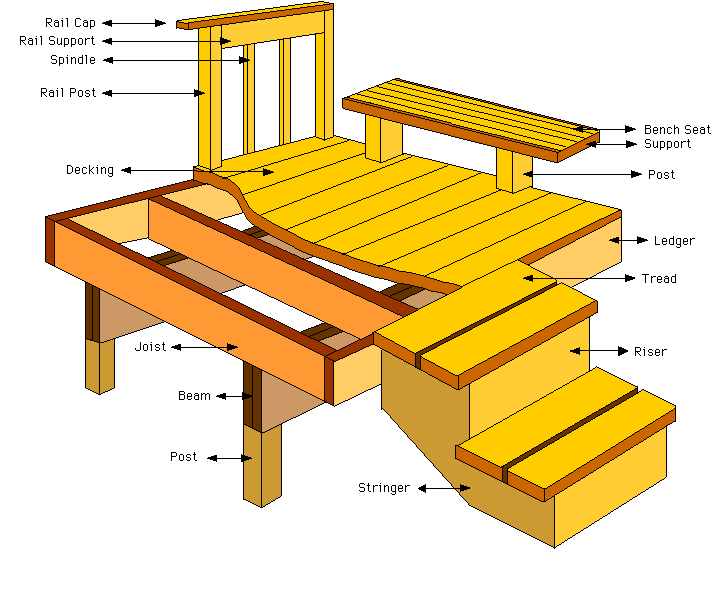Common Deck Terms- A-J
Balusters
The clever boards making up the railing. Balusters connect to the bottom rail and the support rail.Beams
A stiffening deck member supported at its extremities by knee connections to frames or bulkheads. They run horizontally and perpendicular to the joists. Beams transfer weight from the joists to the posts and footings.Box Sill
A sill for a building frame, composed of plate resting on the basement wall and a joist or header at the outer edge of the plate, as well as a soleplate for the studs resting either directly on the joists or on the rough flooring.Decking
The boards that span the area over the joists and form the deck floor. Decking refers to both wood and composite materials. The quality of your decking refers to the quality of boards making up the flooring.Foundation
A concrete pad or post that is installed on top of the footers.Furring Boards
Long thin strips of wood used to help with leveling the deck and helps existing surfaces support the finished surface, in this case the deck.Handrails
Horizontal boards that cap the railings all the way around the deck and down the stairs. They are sometimes referred to as top caps. Hand rails are usually 2×6″ or 5/4×6″ providing a nice wide surface grasping.Joists
Typically 2 x 8″ boards installed perpendicular and between beams that help distribute weight and hold up the decking boards. Joists are installed 16 or 24 inches apart. The species of lumber, the spacing of the joists, and expected design loads all determine what size joists are required. However, each jurisdiction has regulations on joist size and spacing. Make sure your deck is up to code.Image sourced from https://www.pinterest.com/pin/447967494160333453/
Common Deck Terms L-T
Ledger Board
The ledger board is a sturdy structural member that mounts the deck to the house. It’s one of the most important parts of a deck. The ledger board bolts the deck to the vertical structure of the house. Deck safety relies on the condition and correct attachment of the ledger board. Make sure to inspect your ledger board regularly. Also ensure the builder installed proper flashing to prevent moisture damage between the ledger board and the house frame.
Rise
Rise is the height of a step and is often 7 inches depending on personal preference. Riser boards attach from the top of one tread to the bottom of another.
Run
Run is the depth of a step which is often 11 inches depending on personal preference. The tread makes up the run of the step.
Staircase Landing
A level area at the top of a flight of stairs or between two flights of stairs. Landings are usually a 4×4 foot square section of decking. We find landings at the top of steps, connecting them to the deck. Also, landings provide connection between sets of steps on high decks.
Stringers
Boards on the left and right, (and sometimes center) framing the stairs. Stringers outline the rise and run and support the steps. Every set of steps has at least two stringers and some have a third in the center. The stringers are important parts of a deck. The condition of the stringer boards, as well as how it is secured determine the safety of the stair structure.
Importance Of Building Strong Deck Steps
Support Posts
Posts support the weight of the deck usually 4 x 4″ or 6 x 6.” Posts are under the support beams as well as along the perimeter of the deck. Posts along the perimeter make up the framing of the railing.
Treads
The top boards on a stair. The tread is the part where you step that creates the run of the step.





